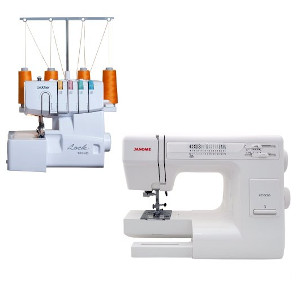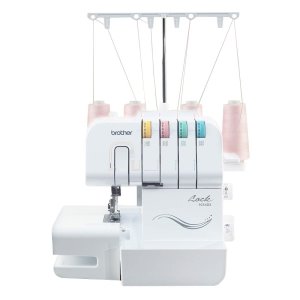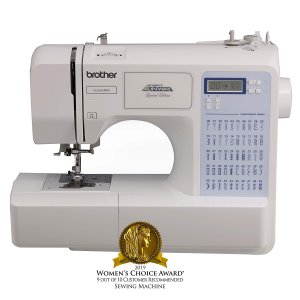 Sewing is quite a broad term that’s used to cover a wide range of different techniques and processes. And while many of these terms are used interchangeably, most are actually quite different from one another. For example, some people who are none the wiser think that tapestry, cross-stitching and embroidery are all one and the same. However, while all three may share some common similarities, there are also some quite distinct differences too.
Sewing is quite a broad term that’s used to cover a wide range of different techniques and processes. And while many of these terms are used interchangeably, most are actually quite different from one another. For example, some people who are none the wiser think that tapestry, cross-stitching and embroidery are all one and the same. However, while all three may share some common similarities, there are also some quite distinct differences too.
The same goes for when people refer to either a sewing machine or a serger machine. For those that have been in the industry a good while, the differences between these two machines are probably quite obvious. But for someone who’s new to the world of sewing, or may have had limited exposure to it, the variants may not be so clear. And, that’s what I hope to clear up for you today.
In this article, I’ll go through the main attributes of a serger machine as well as that of a sewing machine. I’ll also explain in general terms, what each offer when it comes to both functionality and versatility.
What is a Serger Machine?
 A serger machine is also referred to by some as an overlock sewing machine. It’s a kind of specialist machine that works wonders when it comes to creating beautiful and neatly finished edges. The way in which it works is by locking the thread around the seam edge to prevent fraying. They also have blades that can trim the seam allowance as you go along.
A serger machine is also referred to by some as an overlock sewing machine. It’s a kind of specialist machine that works wonders when it comes to creating beautiful and neatly finished edges. The way in which it works is by locking the thread around the seam edge to prevent fraying. They also have blades that can trim the seam allowance as you go along.
Different Types of Sergers
Just as you get different types of sewing machines, you also different types of sergers. These machines take between 3 and 8 thread cones at once and loop the thread around the edge of the fabric, preventing fraying and creating a beautiful finish at the same time. The most common sergers available on the market today use either 3 or 4 cones of thread.
Read More: Which sergers are good for a commercial setting?
Strengths of a Serger
All machines have their strength, weaknesses, and limitations, including a serger. For a serger machine, its main strength lies in that of the speed in which it can run, while still producing professional quality stitching. But it does have its limitations, some of which you’ll discover below. While you can get away with using a sewing machine for the majority of projects, with only a serger machine to use, you are pretty restricted.
How Sergers Differ from Sewing Machines
 Quality of the stitch – As long as you invest in a decent model, both a serger or sewing machine will produce accurate and precise stitching. However, because a serger uses multiple threads, it makes a more professional and durable seam than that you’d find in a standard sewing machine.
Quality of the stitch – As long as you invest in a decent model, both a serger or sewing machine will produce accurate and precise stitching. However, because a serger uses multiple threads, it makes a more professional and durable seam than that you’d find in a standard sewing machine.
Usability – While some of this will come down to skill level, and some of it will come down to the actual machine, in my opinion, sergers are the easier of the two machines to use, simply because there is less to them. There are generally no complicated features to figure out and they offer limited functionality. However, there is one limitation here. You can only serge on the left-hand side of the needles, whereas with a sewing machine you can sew from either side.
Versatility – In terms of what each is capable of sewing, it will vary from model to model, so I’ll try to generalize. As a general rule of thumb, sergers also tend to produce a stronger stitch as they are using multiple strands of thread. However, extremely heavyweight fabrics such as leather or knits can sometimes gather when being sewn on a serger. Therefore, to prevent rippling seams, these materials are best left to a heavy-duty sewing machine.
Functionality – Again, if you’re looking for bells and whistles, a sewing machine is probably more up your street as while sergers are good at what they do, they are slightly more limited. A serger is very good at creating professional seams with the greatest of ease. In addition to this, it also cuts the edge of the fabric as you sew, unlike a sewing machine where you have to trim your material before you sew. But the major downside to sergers is that they cannot create buttonholes, sew zippers, or carry out any topstitching. You would still need a sewing machine to do these tasks.
Speed – When it comes to speed, as close as a comparison you can get between a serger and a sewing machine, the serger will win hands down, every time. If you thought some of the top-spec sewing machines were fast, just wait until you get your hands on one of these. Serger machines are super-fast and can reach speeds of up to 1700 stitches per minute. A sewing machine, on the other hand, is considered to be quick if it can achieve around 850 stitches per minute or more.
Difference Between Serger and Sewing Machine: Final Thoughts
If you’re in need of a machine that’s main focus is speed and quality opposed to features and functionality, then a serger machine is the way to go. They’re extremely fast, very durable, and produce precise and accurate stitching. But, as mentioned above, they are limited in what they can do.
So, if you’d rather have a machine that has a large number of features and functions to offer allowing you to carry out a wide variety of projects, then a sewing machine is almost certainly the better choice for you. These come in various shapes and sizes with a range of different features to enhance your sewing experience.
For anyone who’s new to the world of sewing, while sergers are generally easier to use, in my opinion, I would suggest starting with a sewing machine first, just because it offers more functionality and allows you to learn a broader range of skills.
As mentioned at the beginning of the article, these are two different machines, offering different functionality and capabilities. A serger machine will never take the place of a sewing machine, and vice versa. If you can only afford one, you’re better off buying a sewing machine to begin with as you can do more with it. If however, money’s no issue, or you’ve already got a good sewing machine at home, definitely consider adding a serger to your sewing ensemble. I guarantee you won’t regret it.


